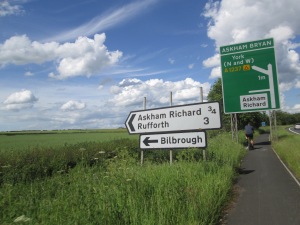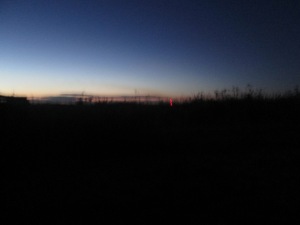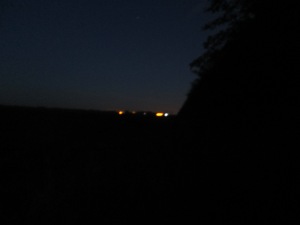‘It’s like’t maze round ‘ere.’ – man in pub, York.
I wonder how the stories and scenery I’ve so far come across would be seen through another’s eyes.
Would the consistently similar and familiar appearances of town centres deaden or enliven their senses? The cheery pessimism people express about each place (‘ooh, it’s bad round here’) which quickly leads to a hearty defence of the town in question – would it confuse them, or would it indicate a common experience of some odd kind? Would they largely distrust the stories and anecdotes I often rely on?
New sights and sounds are continually expanding my mental horizons, but each is computed by the same thing at the centre – me, with all my preoccupations, prejudices and preferences. If you were to travel the route I have taken, you’d come across so many different things. My experiences are not the authoritative account.
I leave Leeds and my cousin in the early afternoon, and head to a nearby supermarket in Meanwood to stock up on food supplies. People around me friendlily hold my bike as I pack up my items and prepare to journey on. I’ve often had good feelings for Leeds, and my time here has not disappointed. As I travel out east I pass through Harehills, a lively but run-down Leeds suburb with a heady cultural and ethnic mix. Tough looking social clubs jostle with sari shops and Polish stores, set out in a distinct Victorian red-brick series of terraced back-to-back houses. The area is dogged with poverty and has been the site of a recent riot, but there’s life to the place.
I move on, joining York Road and heading past Seacroft, a more recent large council estate to the east of Leeds. The place has a bad reputation which may be underscored by the relative spatial isolation of the low-rise houses alongside the visual isolation of the ugly 1960s blocks about the place. Some of the old pubs and sites along the road are familiar to me. My gran lived in a nursing home further down the way for several years. Each time we’d go to see her, we’d often stay in travelodges and eat in harvesters in this bizarre new-build retail park suburbs, true transit zones or non-places of contemporary British life. It’s possible to feel emotional warmth for these things.
A-roads are always easy to follow when cycling. There’s no fear about taking a wrong turn, or following a route that might go through some cramped and tiny footpath or up a staircase. It makes me wonder how public authorities hope to convince more people to cycle though. The bad quality of existing cycle paths, and the paucity of cycle routes between towns, has made this journey difficult and often confusing. Way more money is needed to restore cycling as a common form of transport for all people, not just lycra-clad professionals and sweaty amateurs like myself, hugging the hard shoulder of the A61.
I follow the road to York, my next destination, passing on the way the John Smith brewery at Tadcaster. For the rest of the day I would be unable to get a pint of this local brew. Different pubs would each tell me ‘the brewery won’t allow it’. It’s a shame. There’s little nice about John Smith’s, or Tetley’s, the other local beer, but these beers are extremely cheap and do the job. They’re definitively northern drinks – compromised in composition, a little bland, or sweet, or the taste of home, depending on your taste buds, and increasingly unpopular or hard to come by, except in the right places. When I was younger, John Smiths and Tetleys were often the only non-lager beer you could drink in pubs. It’s intriguing how tastes change, from mild ale to lager, and from alcopops to fruity ciders. Even the most traditional of pubs is a kind of fictional ruse.
I’d been warned before about York. ‘A tourist hellhole’, a Disneyfied pastiche of the past. After Stratford-upon-Avon, I couldn’t imagine it’d be worse. As I drew into the pretty town via the fairly uninteresting middle class suburbs of Dringhouses, I see around me castle fortifications and cobbled lanes, independent shops and pubs and streets full of people speaking with local accents, enjoying themselves. A little closer and some signs of Disneyification do emerge. In almost every corner or opening of the pedestrianized centre, young generic indie bands play, appearing to busk but performing with a setup that clearly requires prior approval. Generic indie has become a kind of contemporary muzak, and I skirt by, avoiding these well-meaning clone acts.
Much of the centre is full of typical British Town Centre high-street chains, and it’s easy to get disorientated. All around me is a pleasant if meticulously preserved image of the past. What makes York stand out from say Leeds or Wakefield is the old age of its buildings. They confer a sense of continued tradition on the place which makes it feel respectable and dignified. It’s as if the industrial revolution never happened.
How did it manage? York is a very wealthy town, and became prominent from the 16th century as a key site of the wool trade. It’s always been a convenient site for local markets, and trade and wealth are built into its story. It’s also had long historical associations with Roman Catholicism, and various monastic orders had York as a key base until the Reformation.
Indeed, York is the home of England’s most well-known terrorist. Guy Fawkes was born here and spent his early years in Stonegate, before making a life as a soldier, drawing him towards the Gunpowder Plot. I would not lionise Guy Fawkes. It seems that the plotters may have been framed, victims of a wider conspiracy to persecute Catholics. No doubt there intention was to kill the Protestant King James and explode parliament with it. Their plans would have led to the installation of a puppet queen and an unpopular religion, had no aim to create a more equal or democratic country.
It reminds me of how often it is that religion forms the basis of a major political revolt in this island’s history. The English Civil War had a subtlely religious basis, as a struggle of Puritanical Parliamentarians against a King and aristocracy that was considered to be secretly Catholic. The Gunpowder plot was a sectarian struggle. Most recently, the 7 July 2005 bombings across London were on behalf of a pro-Islamist cause, yet carried out by four men either from or with connections to Leeds or nearby parts of West Yorkshire. The four who died were young fathers with fairly common jobs, from carpet-fitting to helping run a fish and chips shop. There is long been a particularly distaste for political violence in this country. Perhaps it has a connection to these unpopular and poorly-articulated sectarian causes.
I find the chintziest and most fake-historical place in York to have a drink, Ye Old Starre Inn, the oldest pub in town apparently. It’s appearance suggests a conventional 1990s dark-brown bar with random images and objects on the walls. I order the local brew, Old Peculiar from nearby Masham, and take in the journey so far.
York doesn’t feel remotely northern. As I mentioned, it has been a place of money-making, from wool and trade. The town has long been packed with gentry and merchants, and later it found new fortunes in railways and confectionary, with companies like Rowntree’s and Terry’s once running factories here. There has never been an imperative to pull down its old and pretty buildings.
I wander by to Yorkminster, a grand if unexceptional large cathedral in the centre. Visitors from diverse parts of Asia and North America each work meticulously to ensure no aspect of the cathedral has not been documented with a camera. Constantine was crowned emperor here in 306, beginning the start of an extraordinary reign that would lead to the construction of Byzantium (or Constantinople) in the east, and would lead to the full spread of Christianity across the huge Roman empire. Constantine was the first Christian emperor, and whilst allowing Christianity to spread across the empire, he also introduced a new principle of toleration, making it possible for all worshippers to observe their own religious faith without punishment. He oversaw the construction of the Church of the Holy Sepulchre in Jerusalem, the reported site of Jesus’s birth. These brief details established a legacy that transforms Europe thereafter. Again, there is something vaguely exciting about being in the town where this occurred.
But the Romans were just one group that invaded and made a home in the town. There are the Vikings too, renaming the town ‘Jorvik’, and subsequent generations of Saxons, Angles, and others since. ‘Viking’ once simply referred to a pirate, without any Scandinavian specificity, and it was only after the Battle of Maldon poem (remember?) that some kind of place and culture was attributed to them. From the close of the 8th to the 10th centuries they attacked religious sites and then settled here, establishing communities as they went. Some signs survive: places that end in –by, or –burn, or –fell, or –wall, were probably formed by Scandinavian settlers. Like all migrant groups, the Vikings, like the Romans, did not simply disappear, but become part of the population. This island’s population has rarely ever been homogeneous, and its history is one of migration and struggle.
I spot a Roman column that once belonged to the 6th regiment here, whose logo was the bull, an image probably borrowed from the soldiers’ cult of Mithras. Mithraism was a subterranean religion that became popular in Britain as it did across the Roman world. I like its oddly esoteric systems of belief, and its central motif of a man, Mithras, slaying a bull, which based on your tastes can suggest either discovering a profound inner power that transforms what’s around you, or simply celebrates cutting the bullshit. Either way, adherents of Mithraism would meet together in small halls and eat and drink together, making merry and enjoying themselves. A temple once existed by the Thames, in London, but shamefully local authorities have not restored its remains after recent construction. Mithraism is just one of this island’s many strange and popular systems of belief.
York’s been interesting enough, and I’ve been sad not to have a local guide to point out all its nuances. Instead I’ve made my own investigations. It’s a place worth checking, but today it trades so heavily on its history that for a more authentic taste of the north, one would be better off heading to feisty Leeds.
I leave the town and head out towards Selby. I’m now passing long country roads and looking forward to spending time amongst this new scenery when, alas, a great rain storm hits me on the road. I decide to trudge on, and put up my poncho and anything else waterproof in a vain bid to survive. The elements are keen to disrupt my journey though. Soon after a huge hail storm batters me off the road and drives me into a very fortunately placed pub, the White Swan, in Deighton. The friendly bar-staff tell me that there’s little to do about the place, but I think for countryside-dwellers this is part of the charm and selling point. Why should we always be doing, and not being? I dry off and do a little writing, occasionally peering out for some dry moment. It won’t be til around 8pm that it’s safe to leave.
Darkness is starting to settle in, so I pedal hard to Selby. The road is long but I eventually make it, and come across a small market town with a few lively pubs. I carry on, reaching Carlton and its large house, and soon after, Snaith, by way of a curious bridge. I pass a delicious wheaty smell and realise I’ve just gone by a Hovis bakery, I think. On the road I pass by some spectacular views of the Drax power plant, a name that immediately conjures up images of Dr Who and his tardis. It’s an extraordinary view that haunts the road for many miles: great chimneys bellowing out smoke that seems to become one with the clouds. Over a third of the country’s electricity is produced in this quiet and unlikely spot, largely out of sight from any major town. I want to loaf around and explore, but there are few streetlights and I must press on.
I head on to my final sleeping point, the Humberhead Peatlands, a place I quickly found on Google before I left and which seemed like a possible place to wild-camp. Actually reaching them becomes much more difficult when I arrive. My bike chain comes loose, and twenty minutes poking about with this turns the pretty sunset into full-blown night.
I find a field that looks good enough, and furtively sneak over. I had been dreading camping in the rain earlier, but there’s something immensely thrilling about cheekily assembling a free sleeping place in the middle of nowhere. It’s rough and ready, rogue and silly. I put up the tent just by a hedgerow which just about excludes any drivers from the nearby road viewing the place, and settle in. The midge spray comes in handy, and I gaze out into the evening field. I hear foxes carrying on and ducks honking to each other. Rabbits flit across the paths, and the nearby road carries a gentle hum. I eat a large dinner of tortilla wraps, cheese and beans, call my wife, and gently fall under.





























































































